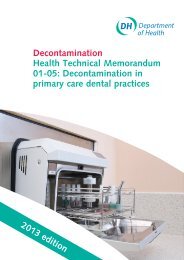A study of Patent Thickets (1.31Mb) - UK Intellectual Property Office
A study of Patent Thickets (1.31Mb) - UK Intellectual Property Office
A study of Patent Thickets (1.31Mb) - UK Intellectual Property Office
Create successful ePaper yourself
Turn your PDF publications into a flip-book with our unique Google optimized e-Paper software.
A Study <strong>of</strong> <strong>Patent</strong> <strong>Thickets</strong> 45<br />
Cout <strong>of</strong> Triples<br />
0 50 100 150 200 250<br />
Count Of Triples in Chemistry<br />
by Area and Priority Year<br />
1980 1985 1990 1995 2000 2005<br />
Priority Year<br />
Organic Chem. Biotechn. Pharmaceuticals Polymers Food Chem.<br />
Materials Chem. Metallurgy Surface Tech. Chem. Eng Env. Techn.<br />
Count <strong>of</strong> triples in chemistry by technology area and priority year<br />
These three figures largely confirm what Figure 2 already indicated. The increases in triples<br />
counts are very high in almost all technology areas within the main area Electrical Engineering,<br />
while they are significantly lower in almost all technology areas within the main areas Instruments<br />
and Chemistry.<br />
Some noteworthy detail emerges, however:<br />
• In Electrical Engineering triple counts are particularly high in the areas <strong>of</strong><br />
Telecommunications, Audiovisual Technology, and Computer Technology.<br />
• In Instruments there is a five-fold increase in the level <strong>of</strong> the triples count between 1995<br />
and 2000 in Optics. We found that the initial growth in triples was driven mainly by<br />
patenting <strong>of</strong> the following firms: Canon, Matsushita, Seiko, and Epson. Subsequently the<br />
high level <strong>of</strong> triples is due to Sony, Ricoh and Samsung.<br />
• In Chemistry we would not expect patent thickets to play a major role, with the possible<br />
exception <strong>of</strong> Biotechnology where it has been repeatedly argued that they may exist.<br />
Figure 5 indicates that if at all a patent thicket may be growing in the area <strong>of</strong> Organic<br />
Chemistry where triples counts doubled between 2000 and 2005.<br />
While these figures provide an indication <strong>of</strong> how dense patent thickets are in different technology<br />
areas, they do not show the structure <strong>of</strong> thickets and the firms involved in it. Figure 6 below<br />
shows the network <strong>of</strong> critical references, which contributed to one or more triples, in the<br />
technology area Telecommunications in the year 2005. The nodes in this figure represent<br />
individual firms. The size <strong>of</strong> the node represents the number <strong>of</strong> limiting citations to the firm’s prior

















